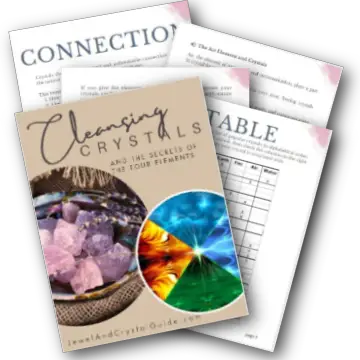Sometimes you just need to know if a piece of aventurine is genuine or fake.
You can tell if aventurine is real by seeing if it sinks in water, scratches steel, comes in a color of real aventurine, sparkles, has a sugary texture when raw, and makes a high-pitched sound when tapped.
In this blog post, I’ll share all the methods and tests you can use to check if aventurine is real or not. While no test is foolproof, doing a few of these will give you a good idea if you’re holding real aventurine or not.
By the end of this post, you’ll have 10 ways to tell if aventurine is real or fake.
Test if aventurine is real with …
A visual inspection
Take a close look at the crystal and look for clues that will tell you if it’s real or fake.
Real Aventurine
- Real aventurine comes in various colors, most often green, but also colors like blue, orange, brown, and more.
- Many aventurine colors shine or glimmer in the light. These metallic-looking sparkles are called “aventurescence.” Even though some aventurine shimmers not all of it does, so if a piece doesn’t have aventurescence it doesn’t mean it’s a definite fake.
- Most real aventurine is translucent or opaque, so you can’t see through it completely but you’ll see some light passing through it, especially if you use a flashlight or the strong light on your phone.
- Raw aventurine has a sandy or sugary texture that can be quite rough to the touch. Once tumbled or polished, aventurine takes on a smooth texture. There may also be patterns or swirls in the crystal.

Fake Aventurine
- Fake aventurine often has a very uniform color throughout, or an unnatural shade that is not commonly found in aventurine. Take note if the color looks too perfect or artificially enhanced.
- Fake aventurine crystals may be extremely shiny or glossy. Compare the crystal to a known genuine piece of aventurine, and you should see the difference. Real aventurine has a subtle shine to it when smooth and polished, not an overpowering one.
A density test
Aventurine has a specific gravity of 2.63 to 2.69, depending on what’s in the gem.
A fairly accurate way to tell if aventurine is real is to measure its specific gravity. Don’t be scared – I’ll show you how!
To get an object’s specific gravity, we measure how much space it takes when we drop it in water.
Here are the steps to calculate the specific gravity of a piece of aventurine:
- Weigh a container and write down the weight up to two decimal places. Make sure the container is large enough to hold water and the aventurine you are testing.
- Add water to the container and take this measurement, again with two decimal places.
- Put the aventurine in the water. Now write down this measurement up to two decimal places.
- Subtract the weight of the empty container from the weight of the water-filled container and the water and aventurine weight. You now have the true weights of the water and the water and aventurine together.
- Divide the true weight of the aventurine and water weight by the true weight of the water-only weight. This gives you the aventurine’s specific gravity.
If the specific gravity of the aventurine is around 2.63 to 2.69, it falls within the typical range for genuine aventurine.
If the specific gravity is significantly out of this range, there might be impurities in the aventurine or it might be a fake. It’s a good idea to use different methods from this blog post to decide if a piece is real aventurine or not.
A floating test
Real aventurine is denser than water. This means it should sink when put in a bowl of water and stay at the bottom of the bowl.
If the crystal floats or stays near the water’s surface, it might not be real crystal but rather a glass or plastic imitation.
A UV light test
To test if a crystal is real aventurine or not, try the UV light test:
- Get a UV black light from Amazon or a local hardware store.
- Wait for nightfall, then turn off the lights in a room to make it as dark as possible.
- Hold the aventurine in your hand or put it on a clean, white surface, then shine the UV light onto the crystal from a few inches away.
- See if the crystal glows under the UV light.
Aventurine itself does not glow under UV light, but the elements that make aventurine sparkle in daylight often glow or fluoresce under UV light.
Try shining the light on areas where the crystal sparkles in daylight and you might see a green glow if there’s fuchsite, or it might glow another color depending on what’s in the crystal.
Most fake aventurine is made of plastic or glass, so it has no reaction under UV light.
A scratch test
The Mohs scale measures how hard minerals are. This scale runs from 1 to 10, with 1 being the softest (talc) and 10 being the hardest (diamonds).
Items on the Mohs scale are ranked above all the things that are softer than them and below all the things that are harder than them.
Real aventurine is a 7 on the Mohs scale, which makes it softer than minerals like topaz and diamonds, but harder than many other minerals.
To tell real aventurine from fake, scratch the crystal with a steel nail or a steel knife. If the steel leaves a mark, the crystal is probably fake because real quartz is harder than steel. If the steel leaves no mark, you have another sign that it’s real aventurine (or at least quartz).
This test works both ways.
Use the crystal to scratch a steel knife. If it leaves a mark then it’s harder than steel and there’s a good chance the crystal is real.
A temperature test
Real aventurine is usually cooler than fake aventurine made from glass.
To test this out, keep a drinking glass in the same area as the aventurine so they both come to room temperature. Place each one on your bottom lip, to see if you can feel a slight difference in temperature.
If the crystal is fake, it should feel like it’s the same temperature as the drinking glass on your lips because both are made from glass. If the crystal is real, it should feel a little cooler than the drinking glass.
If you can’t feel any difference and you want to be sure, use an infrared thermometer, like this one from Amazon, to measure the surface temperature of each.

A sound test
The sound test, also known as the tap test, can give you some clues about the authenticity of aventurine depending on the sound the crystal makes when it’s tapped with another solid object.
Here’s how to do a sound or tap test on aventurine:
1. Hold the aventurine gently between your thumb and forefinger.
2. Use another solid object, such as a metal spoon, and gently tap the stone.
3. Listen to the sound it makes.
Real aventurine tends to make a clear, crisp, and high-pitched sound when tapped. It often has a ringing or chiming quality.
Fake aventurine, which is most likely to be glass or other synthetic materials, usually makes a dull, muted, or flat sound when tapped. It lacks the clear and resonant quality of genuine aventurine.
Is about the same price, no matter where you buy it
The cost of aventurine depends on the quality, color, and size of the piece, as well as how many people want to buy it and how much aventurine is available.
Also, there are a limited number of aventurine suppliers. These suppliers sell aventurine to retailers for about the same price, who sell them on to you and me.
Retailers must sell the aventurine for a certain amount to make a profit, which is more than what they paid to their supplier.
So if you find aventurine that’s on sale for a price that’s too good to be true (much cheaper than other sellers), there’s a chance it’s fake.
Here is a table with the average price ranges of aventurine per gram:
| Quality | Price Range (USD) |
| Low-grade aventurine | $0.10 – $1 per gram |
| Medium-grade aventurine | $1 – $5 per gram |
| High-grade aventurine | $5 – $20 per gram |
Comes from a trustworthy seller
If you buy aventurine from a seller that you know you can trust, and that seller tells you the aventurine is real, then it probably is.
Some things you can do to make sure the seller can be trusted is:
- Do some research on the seller, to look for bad reviews or complaints that other people have made. You can also speak to others or join Facebook groups and ask for recommendations.
- Check the seller’s website to see what information they give and if they look authentic.
- Ask the seller to provide proof on where they got the aventurine from.
- Buy aventurine jewelry that is certified by the Gemological Institute of America (GIA) or the gem certification body in your country.
Can be confirmed by a professional
If you must know if a specimen is real aventurine or not, and none of the above methods have given you a definitive answer, then ask a professional dealer, lapidist, or appraiser to take a look at the aventurine.
A professional will have the tools, knowledge, and experience to give you a better idea if a piece of aventurine is real or not.











